Tarek Ahmed. Reservoir engineering handbook
Подождите немного. Документ загружается.


converted into injectors. However, moving the location of injection
wells frequently requires laying longer surface water lines and
adding costs.
• Results from peripheral flooding are more difficult to predict. The dis-
placing fluid tends to displace the oil bank past the inside producers,
which are thus difficult to produce.
• Injection rates are generally a problem because the injection wells con-
tinue to push the water greater distances.
Regular Injection Patterns
Due to the fact that oil leases are divided into square miles and quarter
square miles, fields are developed in a very regular pattern. A wide vari-
ety of injection-production well arrangements have been used in injec-
tion projects. The most common patterns, as shown in Figure 14-9, are
the following:
• Direct line drive. The lines of injection and production are directly
opposed to each other. The pattern is characterized by two parameters:
a = distance between wells of the same type, and d = distance between
lines of injectors and producers.
• Staggered line drive. The wells are in lines as in the direct line, but the
injectors and producers are no longer directly opposed but laterally dis-
placed by a distance of a/2.
• Five spot. This is a special case of the staggered line drive in which
the distance between all like wells is constant, i.e., a = 2d. Any four
injection wells thus form a square with a production well at the center.
• Seven spot. The injection wells are located at the corner of a hexagon
with a production well at its center.
• Nine spot. This pattern is similar to that of the five spot but with
an extra injection well drilled at the middle of each side of the
square. The pattern essentially contains eight injectors surrounding
one producer.
The patterns termed inverted have only one injection well per pat-
tern. This is the difference between normal and inverted well
arrangements. Note that the four-spot and inverted seven-spot patterns
are identical.
878 Reservoir Engineering Handbook
Reservoir Eng Hndbk Ch 14 2001-10-25 17:37 Page 878
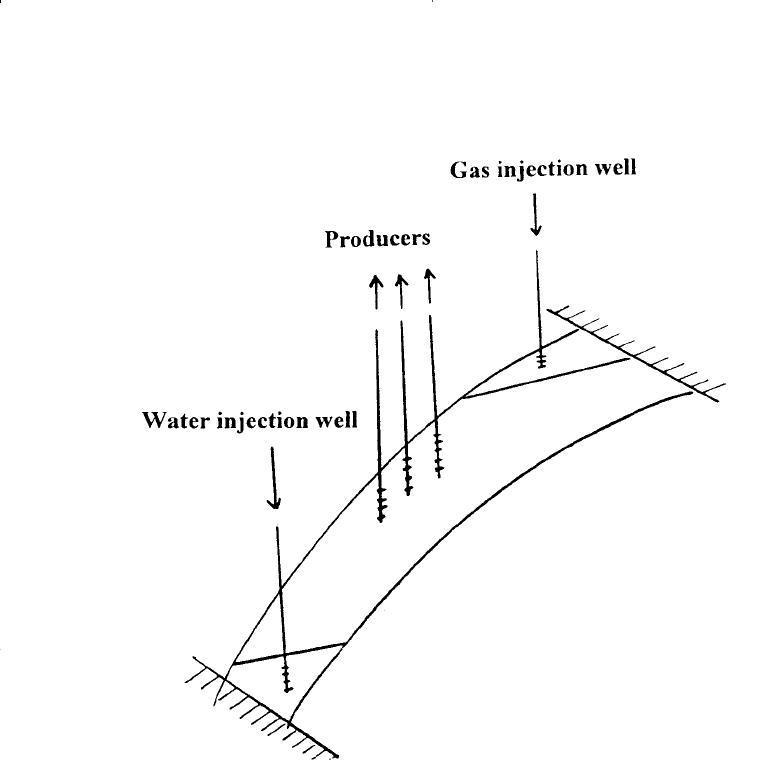
Crestal and Basal Injection Patterns
In crestal injection, as the name implies, the injection is through
wells located at the top of the structure. Gas injection projects typical-
ly use a crestal injection pattern. In basal injection, the fluid is injected
at the bottom of the structure. Many water-injection projects use basal
injection patterns with additional benefits being gained from gravity
segregation. A schematic illustration of the two patterns is shown in
Figure 14-10.
Principles of Waterflooding 879
Figure 14-10. Well arrangements for dipping reservoirs.
Reservoir Eng Hndbk Ch 14 2001-10-25 17:37 Page 879

OVERALL RECOVERY EFFICIENCY
The overall recovery factor (efficiency) RF of any secondary or tertiary
oil recovery method is the product of a combination of three individual
efficiency factors as given by the following generalized expression:
In terms of cumulative oil production, Equation 14-5 can be written as:
where RF = overall recovery factor
N
S
= initial oil in place at the start of the flood, STB
N
P
= cumulative oil produced, STB
E
D
= displacement efficiency
E
A
= areal sweep efficiency
E
V
= vertical sweep efficiency
The displacement efficiency E
D
is the fraction of movable oil that has
been displaced from the swept zone at any given time or pore volume
injected. Because an immiscible gas injection or waterflood will always
leave behind some residual oil, E
D
will always be less than 1.0.
The areal sweep efficiency E
A
is the fractional area of the pattern that
is swept by the displacing fluid. The major factors determining areal
sweep are:
• Fluid mobilities
• Pattern type
• Areal heterogeneity
• Total volume of fluid injected
The vertical sweep efficiency E
V
is the fraction of the vertical section
of the pay zone that is contacted by injected fluids. The vertical sweep
efficiency is primarily a function of:
• Vertical heterogeneity
• Degree of gravity segregation
• Fluid mobilities
• Total volume injection
N = N E E E (14 - 6)
PSDAV
RF E E E
DAV
= (14 - 5)
880 Reservoir Engineering Handbook
Reservoir Eng Hndbk Ch 14 2001-10-25 17:37 Page 880
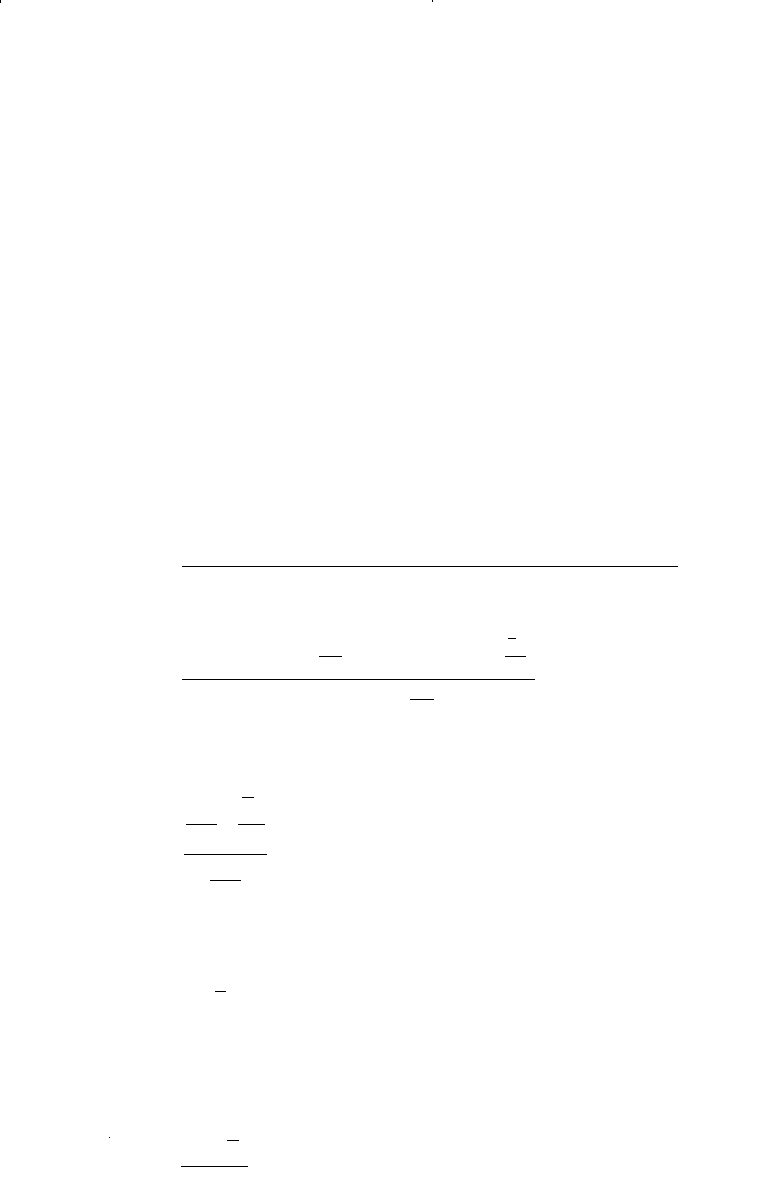
Note that the product of E
A
E
V
is called the volumetric sweep efficiency
and represents the overall fraction of the flood pattern that is contacted
by the injected fluid.
All three efficiency factors (i.e., E
D
, E
A
, and E
V
) are variables that
increase during the flood and reach maximum values at the economic
limit of the injection project. Each of the three efficiency factors is dis-
cussed individually and methods of estimating these efficiencies are
presented.
I. DISPLACEMENT EFFICIENCY
As defined previously, displacement efficiency is the fraction of mov-
able oil that has been recovered from the swept zone at any given time.
Mathematically, the displacement efficiency is expressed as:
or
where S
oi
= initial oil saturation at start of flood
B
oi
= oil FVF at start of flood, bbl/STB
o
= average oil saturation in the flood pattern at a
particular point during the flood
Assuming a constant oil formation volume factor during the flood life,
Equation 14-7 is reduced to:
E
SS
S
D
oi o
oi
=
−
(14 - 8)
S
E
S
B
S
B
S
B
D
oi
oi
o
o
oi
oi
=
−
(14 - 7)
E
E
D
D
S
B
S
B
S
B
oi
oi
o
o
oi
oi
=
−
=
(
)
(
)
−
(
)
(
)
(
)
(
)
Volume of oil at start of flood Remaining oil volume
Volume of oil at start of flood
Pore volume Pore volume
Pore volume
Principles of Waterflooding 881
Reservoir Eng Hndbk Ch 14 2001-10-25 17:37 Page 881

where the initial oil saturation S
oi
is given by:
However, in the swept area, the gas saturation is considered zero, thus:
The displacement efficiency E
D
can be expressed more conveniently in
terms of water saturation by substituting the above relationships into
Equation 14-8, to give:
where
w
= average water saturation in the swept area
S
gi
= initial gas saturation at the start of the flood
S
wi
= initial water saturation at the start of the flood
If no initial gas is present at the start of the flood, Equation 14-9 is
reduced to:
The displacement efficiency E
D
will continually increase at different
stages of the flood, i.e., with increasing
w
. Equation 14-8 or 14-10 sug-
gests that E
D
reaches its maximum when the average oil saturation in the
area of the flood pattern is reduced to the residual oil saturation S
or
or,
equivalently, when
w
= 1 – S
or.
Example 14-4
A saturated oil reservoir is under consideration to be waterflooded
immediately after drilling and completion. Core analysis tests indicate
that the initial and residual oil saturations are 70 and 35%, respectively.
S
S
E
SS
S
D
wwi
wi
=
−
−1
(14 -10)
S
E
SS S
SS
D
wwigi
wi gi
=
−−
−−1
(14 - 9)
SS
ow
=−1
SSS
oi wi gi
=− −1
882 Reservoir Engineering Handbook
Reservoir Eng Hndbk Ch 14 2001-10-25 17:37 Page 882
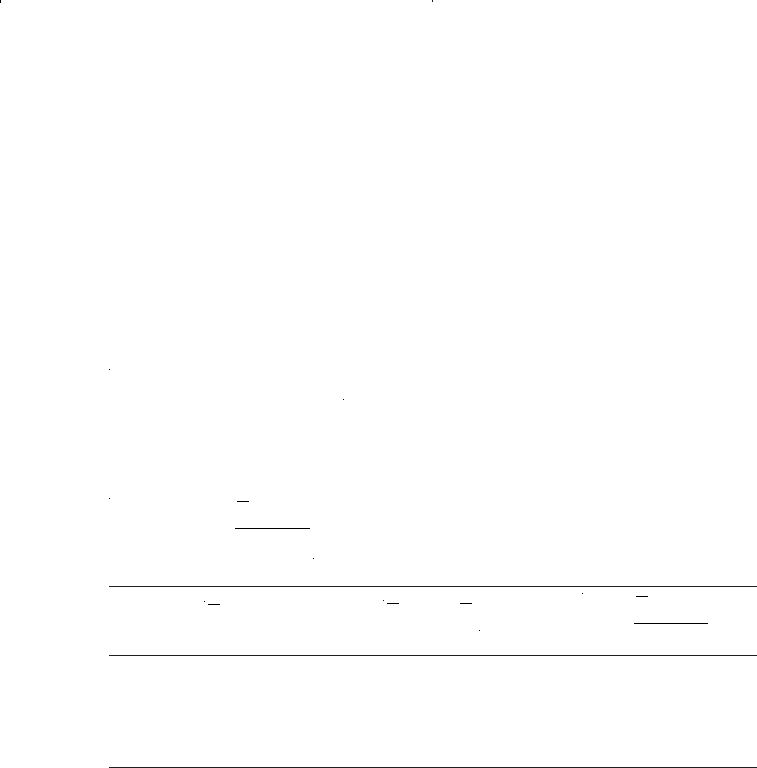
Calculate the displacement efficiency when the oil saturation is reduced
to 65, 60, 55, 50, and 35%. Assume that B
o
will remain constant through-
out the project life.
Solution
Step 1. Calculate initial water saturation:
Step 2. Calculate E
D
from Equation 14-10:
0.65 0.35 0.071
0.60 0.40 0.142
0.55 0.45 0.214
0.50 0.50 0.286
S
or
= 0.35 0.65 0.500 (maximum)
Example 14-4 shows that E
D
will continually increase with increasing
water saturation in the reservoir. The problem, of course, lies with develop-
ing an approach for determining the increase in the average water satura-
tion in the swept area as a function of cumulative water injected (or injec-
tion time). Buckley and Leverett (1942) developed a well-established
theory, called the frontal displacement theory, which provides the basis for
establishing such a relationship. This classic theory consists of two equa-
tions:
• Fractional flow equation
• Frontal advance equation
The frontal displacement theory and its main two components are dis-
cussed next.
E
SS
S
D
wwi
wi
=
−
−1
SS
wo
=−1
S
o
E
SS
S
D
wwi
wi
=
−
−1
S
wi
=− =107 03..
Principles of Waterflooding 883
Reservoir Eng Hndbk Ch 14 2001-10-25 17:37 Page 883
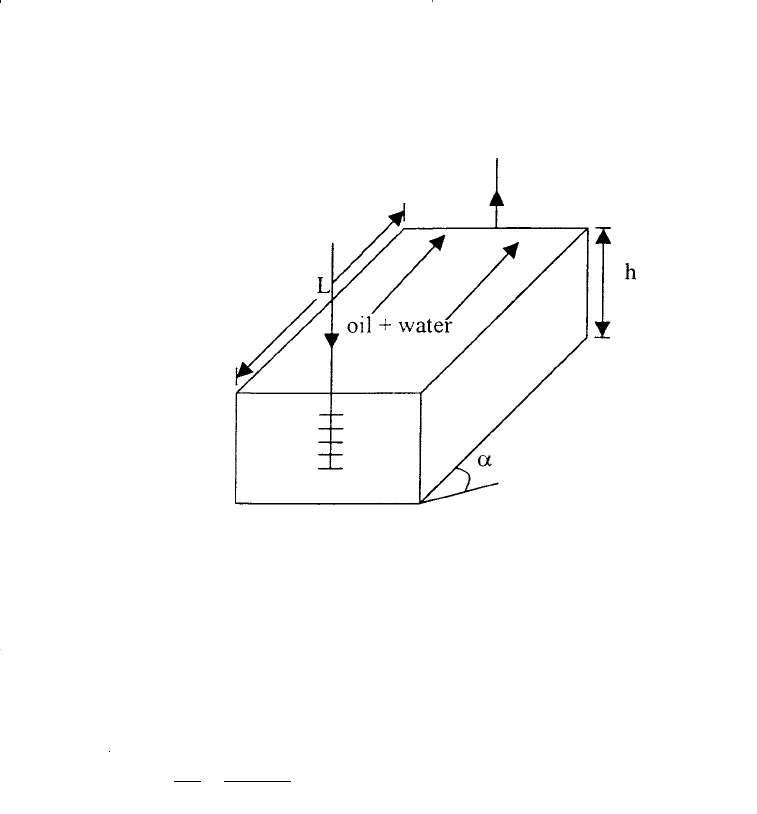
Fractional Flow Equation
The development of the fractional flow equation is attributed to Lev-
erett (1941). For two immiscible fluids, oil and water, the fractional flow
of water, f
w
(or any immiscible displacing fluid), is defined as the water
flow rate divided by the total flow rate, or:
where f
w
= fraction of water in the flowing stream, i.e., water cut,
bbl/bbl
q
t
= total flow rate, bbl/day
q
w
= water flow rate, bbl/day
q
o
= oil flow rate, bbl/day
Consider the steady-state flow of two immiscible fluids (oil and water)
through a tilted-linear porous media as shown in Figure 14-11. Assuming
a homogeneous system, Darcy’s equation can be applied for each of the
fluids:
f
q
q
q
qq
w
w
t
w
wo
==
+
(14 -11)
884 Reservoir Engineering Handbook
Figure 14-11. Linear displacement in a tilted system.
Reservoir Eng Hndbk Ch 14 2001-10-25 17:37 Page 884
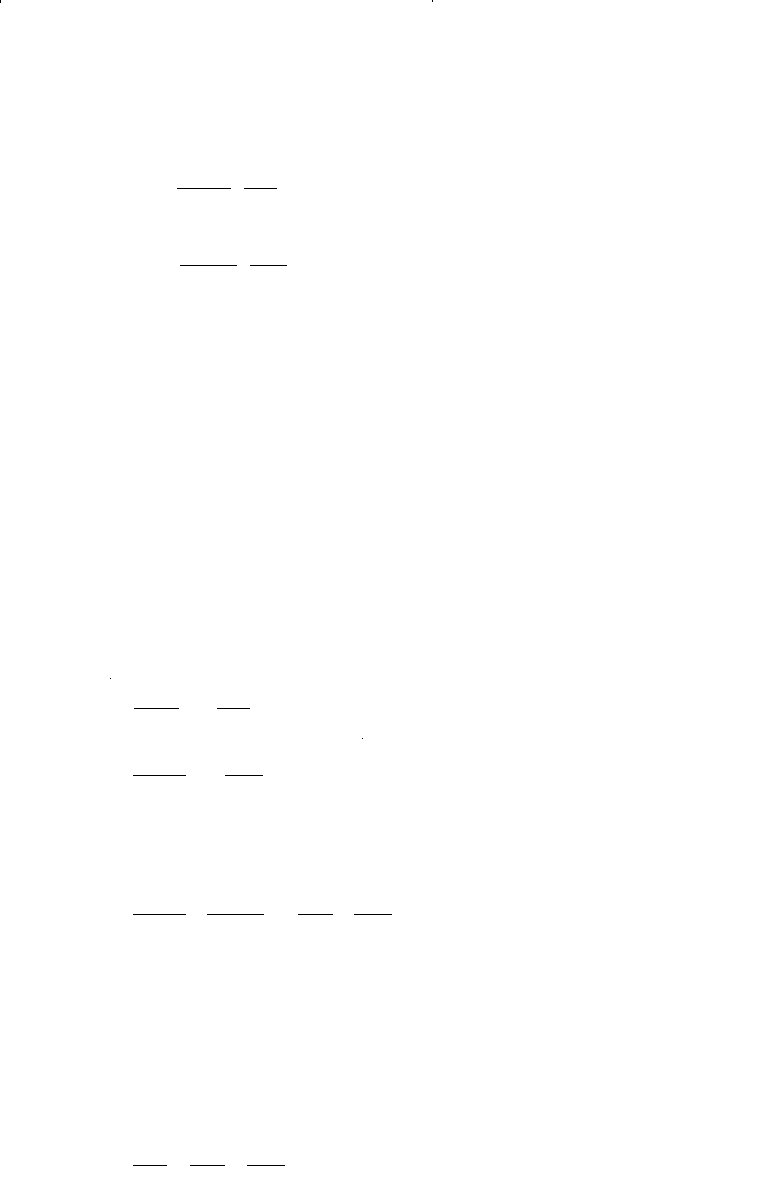
where subscripts o, w = oil and water
k
o
, k
w
= effective permeability
o
,
w
= viscosity
p
o
, p
w
= pressure
o
,
w
= density
A = cross-sectional area
x = distance
= dip angle
sin () = positive for updip flow and
negative for downdip flow
Rearranging Equations 14-12 and 14-13 gives:
Subtracting the above two equations yields:
From the definition of the capillary pressure p
c
:
Differentiating the above expression with respect to the distance x gives:
∂
∂
=
∂
∂
−
∂
∂
p
x
p
x
p
x
cow
(14 -15)
Ppp
cow
=−
q
Ak
q
Ak
p
x
p
x
g
ww
w
oow
o
ow
wo
µµ
ρρ α−=
∂
∂
−
∂
∂
−−
(
)
sin (14 -14)
q
Ak
p
x
g
ww
w
w
w
µ
ρα=−
∂
∂
− sin( )
q
kA P
x
g
w
w
w
w
w
=
−∂
∂
+
µ
ραsin( ) (14 -13)
q
kA P
x
g
o
o
o
o
o
=
−∂
∂
+
µ
ραsin( ) (14 -12)
q
Ak
p
x
g
oo
o
o
o
µ
ρα=−
∂
∂
− sin( )
Principles of Waterflooding 885
Reservoir Eng Hndbk Ch 14 2001-10-25 17:37 Page 885
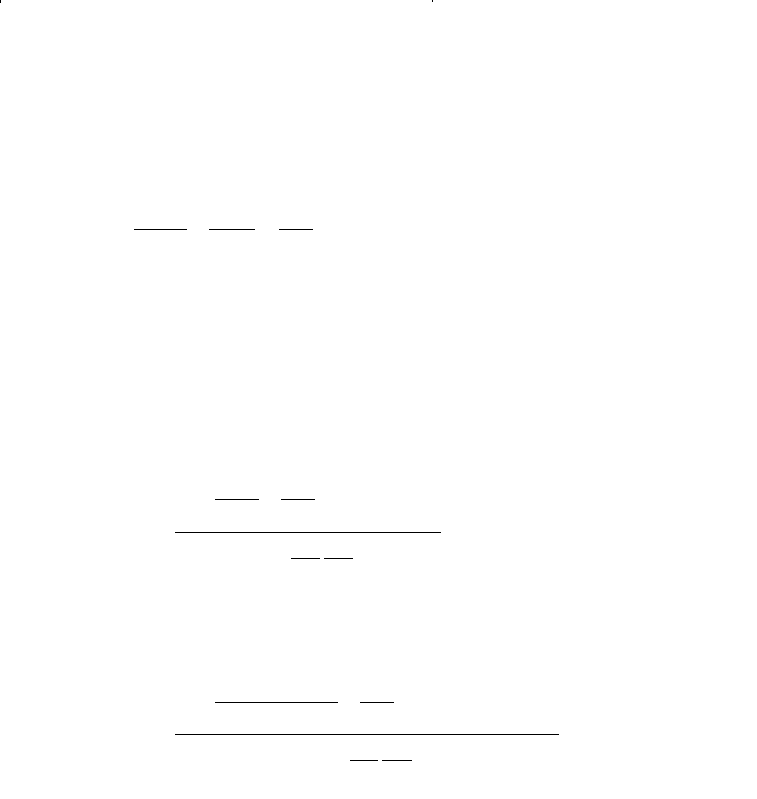
Combining Equation 14-15 with 14-16 gives:
where ∆ =
w
–
o
. From the water cut equation, i.e., Equation 14-11:
Replacing q
o
and q
w
in Equation 14-16 with those of Equation 14-17
gives:
In field units, the above equation can be expressed as:
where f
w
= fraction of water (water cut), bbl/bbl
k
o
= effective permeability of oil, md
k
w
= effective permeability of water, md
= water–oil density differences, g/cm
3
k
w
= effective permeability of water, md
q
t
= total flow rate, bbl/day
o
= oil viscosity, cp
w
= water viscosity, cp
A = cross-sectional area, ft
2
Noting that the relative permeability ratios k
ro
/k
rw
= k
o
/k
w
and,
for two-phase flow, the total flow rate q
t
are essentially equal to the
f
kA
q
p
x
k
k
w
o
ot
c
o
w
w
o
=
+
∂
∂
−
(
)
+
1
0 001127
0 433
1
.
. sin
µ
ρα
µ
µ
∆
(14 -18)
f
kA
q
p
x
g
k
k
w
o
ot
c
o
w
w
o
=
+
∂
∂
−
(
)
+
1
1
µ
ρα
µ
µ
∆ sin
q f q and q f q
wwt o wt
==−
(
)
1 (14 -17)
q
Ak
q
Ak
p
x
g
ww
w
oo
o
c
µµ
ρα−=
∂
∂
−
(
)
∆ sin (14 -16)
886 Reservoir Engineering Handbook
Reservoir Eng Hndbk Ch 14 2001-10-25 17:37 Page 886

water injection rate, i.e., i
w
= q
t
, Equation 14-18 can be expressed more
conveniently in terms of k
ro
/k
rw
and i
w
as:
where i
w
= water injection rate, bbl/day
f
w
= water cut, bbl/bbl
k
ro
= relative permeability to oil
k
rw
= relative permeability to water
k = absolute permeability, md
The fractional flow equation as expressed by the above relationship
suggests that for a given rock–fluid system, all the terms in the equation
are defined by the characteristics of the reservoir, except:
• water injection rate, i
w
• water viscosity,
w
• direction of the flow, i.e., updip or downdip injection
Equation 14-19 can be expressed in a more generalized form to
describe the fractional flow of any displacement fluid as:
where the subscript D refers to the displacement fluid and ∆ρ is defined
as:
For example, when the displacing fluid is immiscible gas, then:
∆ρ ρ ρ=−
Do
f
kk A
i
p
x
k
k
D
rD
oD
c
ro
rD
D
o
=
+
∂
∂
−
(
)
+
1
0 001127
0 433
1
.
.
()
sin
(14 - 20)
µ
ρα
µ
µ
∆
f
kk
A
i
p
x
k
k
w
ro
ow
c
ro
rw
w
o
=
+
(
)
∂
∂
−
(
)
+
1
0 001127
0 433
1
.
.
µ
ρα
µ
µ
∆ sin
(14 -19)
Principles of Waterflooding 887
Reservoir Eng Hndbk Ch 14 2001-10-25 17:37 Page 887
